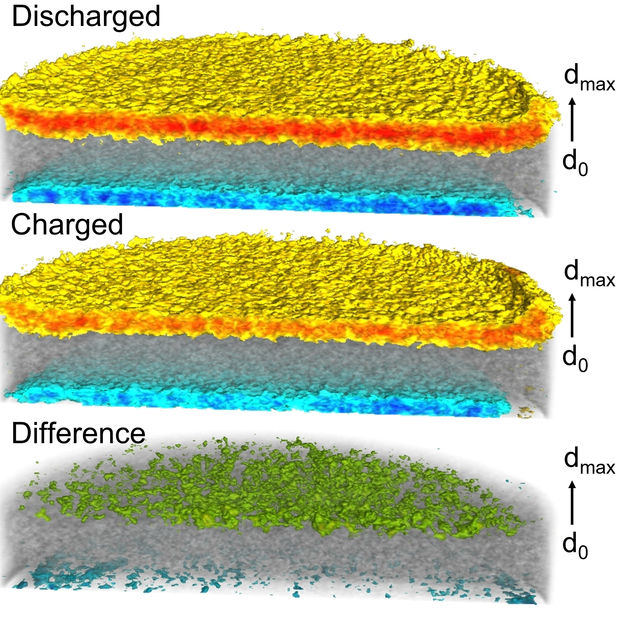Bottleneck identified: researchers discover the cause of long charging times for solid-state batteries
Solid-State Lithium-Sulfur Batteries: Neutrons unveil sluggish charge transport
Solid-state Lithium-Sulfur batteries offer the potential for much higher energy densities and increased safety, compared to conventional lithium-ion batteries. However, the performance of solid-state batteries is currently lacking, with slow charging and discharging being one of the primary causes. Now, a new study from HZB shows that sluggish lithium ion transport within a composite cathode is the cause of this slow charging and discharging.

3-D tomography images of the discharged state (top) and the recharged state (middle), as well as the difference between the two (bottom), showing where the mobile lithium ions (green) are located.
© HZB
The scientists designed a special cell in order to observe the transport of lithium-ions between the anode and the cathode in a solid-state Lithium-Sulfur battery. Since lithium can hardly be detected with x-ray methods, HZB physicists Dr. Robert Bradbury and Dr. Ingo Manke examined the sample cell with neutrons, which are extremely sensitive to lithium. In conjunction with Dr. Nikolay Kardjilov, HZB, they used neutron radiography and neutron tomography methods on the CONRAD2 instrument at the Berlin neutron source BER II. Groups from Giessen (JLU), Braunschweig (TUBS) and Jülich (FZJ) were also involved in the work.
Lithium ions observed directly
"We now have much better idea what is limiting the battery performance," says Bradbury: "We see from the operando neutron radiography data that there is a reaction front of lithium ions propagating through the composite cathode confirming the negative influence of a low effective ionic conductivity." Additionally, the 3D neutron tomography images show trapped lithium concentrated near the current collector during recharging. "This results in a diminished capacity because only some of the lithium is transported back when the battery is charged."
The observed lithium distribution was an excellent fit to a model based on the theory of porous electrodes: "What we observe here in the neutron imaging data correlates well with the relevant electronic and ionic conductivity conditions from the model" says Bradbury.
Bottleneck identified
These results unveil a previously overlooked development bottleneck for solid-state batteries, showing that limitations exist in the cathode composites due to the slow ionic transport. The challenge now is to enable faster ion delivery within the cathode composite. "Without direct visualization of the reaction front inside the cathode composite this effect might have gone unnoticed, despite its importance for solid-state battery development," Bradbury says.
Original publication
Most read news
Original publication
Advanced Energy Materials (2023): Visualizing reaction fronts and transport limitations in solid-state Li-S batteries via operando neutron imaging; Robert Bradbury, Georg F. Dewald, Marvin A. Kraft, Tobias Arlt, Nikolay Kardjilov, Jürgen Janek, Ingo Manke, Wolfgang G. Zeier, Saneyuki Ohno
Organizations

Get the analytics and lab tech industry in your inbox
By submitting this form you agree that LUMITOS AG will send you the newsletter(s) selected above by email. Your data will not be passed on to third parties. Your data will be stored and processed in accordance with our data protection regulations. LUMITOS may contact you by email for the purpose of advertising or market and opinion surveys. You can revoke your consent at any time without giving reasons to LUMITOS AG, Ernst-Augustin-Str. 2, 12489 Berlin, Germany or by e-mail at revoke@lumitos.com with effect for the future. In addition, each email contains a link to unsubscribe from the corresponding newsletter.


























































